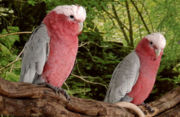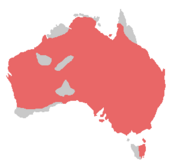Galah
2008/9 Schools Wikipedia Selection. Related subjects: Birds
| Galah | ||||||||||||||||
|---|---|---|---|---|---|---|---|---|---|---|---|---|---|---|---|---|
 Pair of Galahs
|
||||||||||||||||
| Conservation status | ||||||||||||||||
| Scientific classification | ||||||||||||||||
|
||||||||||||||||
| Binomial name | ||||||||||||||||
| Eolophus roseicapillus Vieillot, 1817 |
||||||||||||||||
 Galah range (in red; all-year resident)
|
||||||||||||||||
| Synonyms | ||||||||||||||||
|
Cacatua roseicapilla Vieillot, 1817 |
The Galah, Eolophus roseicapillus, (IPA: /gəˈlaː/) is also known as the Rose-breasted Cockatoo or Galah Cockatoo. It is one of the most common and widespread cockatoos, and it can be found in open country in almost all parts of mainland Australia. It is endemic in Australia (including Tasmania), where its distinctive pink and grey plumage and its bold and loud behaviour make it a familiar sight in The Bush and increasingly in urban areas. It appears to have benefited from the change in the landscape since European colonization and may be replacing the rare Major Mitchell's Cockatoo in parts of its range.
The term galah is derived from gilaa, a word found in Yuwaalaraay and neighbouring Aboriginal languages.
Description
Galahs have a pale grey to mid-grey back, a pink face and chest, and a light pink crest. The sexes appear similar, however generally adult birds differ in eye colour; the male has a very dark brown (almost black) iris, and the female has a mid-brown/red iris. Typical birds are about 350mm long and weigh between 300 and 400 grams.
Distribution and habitat
Galahs are found in all Australian states, and are absent only from the driest areas and the far north of Cape York Peninsula. They appear to have been self-introduced to Tasmania. They are common in some metropolitan areas, for example Perth and Melbourne, and common to abundant in open habitats which offer at least some scattered trees for shelter. The changes wrought by European settlement, a disaster for many species, have been highly beneficial for the galah because of the clearing of forests in fertile areas and the provision of stock watering points in arid zones.
Classification
The classification of the Galah was difficult. It was separated in the monotypic genus Eolophus, but the further relationships were not clear. There are obvious morphological similarities between the galah and the white cockatoos that make up the genus Cacatua and indeed the galah was initially described as Cacatua roseicapilla. Early DNA studies allied the galah with the cockatiel or placed it close to some Cacatua species of completely different appearance. In consequence, it was thought that the ancestors of the galah, the cockatiel and Major Mitchell's Cockatoo diverged from the main white cockatoo line at some stage prior to that group's main radiation; this was indeed correct except for the placement of the cockatiel. Ignorance of this fact, however, led to attempts to resolve the evolutionary history and prehistoric biogeography of the cockatoos, which ultimately proved fruitless because they were based on invalid assumptions to start with.
It fell to the study of Brown & Toft (1999) to compare the previously available data with their mitochondrial 12S rRNA sequence research and resolve the issue. Today, the galah is seen, along with Major Mitchell's Cockatoo, as an early divergence from the white cockatoo lineage which have not completely lost their ability to produce an overall pink (Major Mitchell's) or pink and grey (galah) body plumage, while already being light in colour and non-sexually dimorphic. The significance of these two (and other) characters shared by the Cacatuinae had previously been explained away in earlier studies by strict application of parsimony on misinterpreted data.
Aviary-bred crosses of galahs and Major Mitchell's Cockatoos have been bred in Sydney, with the tapered wings of the galah and the crest and colours of the Major Mitchell's, as well as its plaintive cry. The Galah has also been shown to be capable of hybridizing with the Cockatiel, producing offspring described by the media as 'Galatiels'.
Subspecies
Three subspecies are usually recognised. The south-eastern form, E. r. albiceps, is clearly distinct from the paler-bodied Western Australian nominate subspecies, E. r. roseicapillus, although the extent and nature of the central hybrid zone remains undefined. Most pet birds outside Australia are the south-eastern form. The third form, E. r. kuhli, found right across the northern part of the continent, tends to be a little smaller and is distinguished from albiceps by differences in the shape and colour of the crest, although its status as a valid subspecies is uncertain.
Aviculture
Like most other cockatoos, Galahs create strong life-long bonds with their partners.
Galahs as pets
Galahs are highly social and very long-lived; though they are sometimes kept as pets, this is not something to be undertaken lightly as they bond socially with their owners and may well outlive them, and like most cockatoos, are noisy and require a great deal of attention and care. Both male and female galahs are great talkers but the male is thought to be the better talker. They're very loving and affectionate birds which form a very strong bond with their owner and like to think of themselves as 'part of the family'. However, they do like their privacy at times and are quite happy to simply be around the family rather than be handled all hours of the day.The galah is also very affectionate.
Australian slang term
"Galah" is also derogatory Australian slang, synonymous with 'fool' or ' idiot'. Because of the bird's distinctive bright pink, it is also used for gaudy dress. A detailed, yet comedic description of the Australian slang term can be found in the standup comedy performance of Paul Hogan, titled Stand Up Hoges. Another famous user of the slang galah is Alf Stewart from Home and Away who is often heard saying "Flaming galah!" when he is riled by somebody.
The Australian representative team of footballers which played a series of test matches of International Rules Football against Irish sides in the late 1960s was nicknamed "The Galahs" (see "The Australian Football World Tour).
